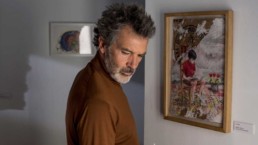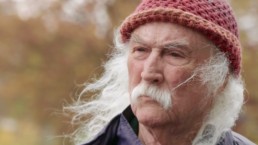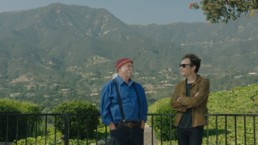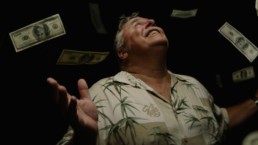Everything’s Not All Roses in 'The Burnt Orange Heresy'
A pair of sexy actors join forces with a couple of movie and music legends to shoot a film noir in Italy.
All set against the backdrop of the art world. Sounds like heaven, right? At least on paper.
The Burnt Orange Heresy has all the makings of a taut thriller: An aging artist, a greedy collector, and a couple whose rendezvous quickly turns sinister duke it out in a tale about an artwork no one’s ever seen. The cast is impeccable: Mick Jagger, Donald Sutherland, in-demand actress Elizabeth Debicki and Danish leading man Claes Bang.
The movie mostly lives up to its promise: Bang plays a once-prominent art critic (and failed artist) James Figueras who’s collecting a paycheck by spinning tales that may or may not qualify as art history to tourists in Milan. And who should glide into his classroom but mysterious American Berenice Hollis (Debicki)?
Within minutes the two are in bed, and minutes after that, off to the Lake Como villa of esteemed art collector Joseph Cassidy (Jagger.) The movie takes off when Jagger’s on screen. He’s done his homework and figured out Figueras, revealing him to be a bit of a cad with a shady past. Hollis’ story, or what we know of it, also seems a bit shallow: she claims to be a Minnesota schoolteacher who’s running away from a bad relationship. Who’s telling the truth? What secrets are they hiding?
Cassidy makes Figueras an offer he can’t refuse: Turns out recluse Jerome Debney, an aging painter played by Sutherland, is living on the property. Debney’s a legend of sorts who hasn’t been heard from for decades after a series of fires destroyed his masterworks. The scoop of the century awaits Figueras if he nabs an interview with Debney. But there’s a catch: Figueras needs to steal a painting for Cassidy...
Debney is delightful and slightly devilish, and, like Cassidy, talks circles around the couple. He also connects with Hollis in a way that opens up the possibility that they’ve met before. Figueras, though, takes us for a ride: What should have been a fairly easy absconding of the painting goes south fairly quickly with a dire outcome.
Based on Charles Willeford’s noir novel, The Burnt Orange Heresy should be a juicy yarn. This is Giuseppe Capotondi’s English language debut, and noir is a genre he’s tackled previously with The Double Hour. But while the cast is letter-perfect, the movie doesn’t sustain the tension as hoped. Who’s been set up? Is anyone telling the truth about their identity and what they’re doing in Italy? And why is Figueras so damn evil (and Hollis not acting on the intelligence she clearly possesses?) A little back story could have gone a long way.
Like its title, The Burnt Orange Heresy is a little perplexing. Questions of art, truth, ambition, and failure hang in the air. Although the movie ends with a fitting denouement, one can’t help but wonder if the movie’s third act could have hung together a little more tightly, this would have been a real gem.
THE BURNT ORANGE HERESY
Starring Claes Bang, Elizabeth Debicki, Donald Sutherland, Mick Jagger, Rosalind Halstead, and Alessandro Fabrizi
Director: Giuseppe Capotondi
Written by: Scott B. Smith, based on the novel by Charles Willeford
Distributed by Sony Pictures Classics. 98 minutes. Opens March 6 at the Landmark and AMC Theaters.
'Ernie & Joe': Poster Boys For a Kinder, Gentler Police Force
“Let’s stop being so afraid,” is one of the mantras two San Antonio policemen use to encapsulate their philosophy toward policing, where their most powerful weapons are words rather than guns.
An antidote to the ceaseless headlines about police brutality, the documentary Ernie & Joe: Crisis Cops goes a long way toward showing how a kinder, gentler police force can guide those who need help land in rehab rather than a jail cell.
The HBO documentary, awarded the Special Jury Prize at the 2019 SXSW Film Festival, is something of a serious buddy cop movie. Director Jenifer McShane (Mothers of Bedford) spotlights the work and personal lives of two San Antonio police officers, Ernie Stevens and Joe Smarro. The men, a decade or so apart in age, play off each other’s strengths, partnering to engage with a troubled community that many of their fellow officers confront with weapons.
Ernie and Joe are part of the San Antonio Police Department’s Mental Health Unit, a 10-person unit that began in the early 2000s to help relieve the city’s overcrowded jail system. The unit is part of an innovative collaboration between the city’s police and mental health services, which also help sponsor a 37-acre treatment center. This program appears to be an overwhelming success: The Atlantic reported that as of 2016, the unit’s work kept 100,000 people away from jail and ERs.
Dressed in plain clothes and driving unmarked cars, Ernie and Joe respond to “mental health” related calls, often involving life-threatening situations. One such call concerns Jessica, a self-described suicidal crack addict, who, in the middle of the night, threatens to jump off the city’s Jones Maltsberger Bridge. “I’m broken,” she cries as the policemen, who frequently sit down rather than tower over citizens, use talk therapy to coax her off the ledge and deliver her to a treatment center. As the film progresses, we see the policemen periodically checking in on her to gauge her sometimes bumpy road to recovery.
Ernie & Joe follows a conventional documentary structure. Still, the nature of the story keeps viewers engaged and wondering if any of the 911 calls Ernie and Joe respond to will go wrong despite their best efforts.
All who join the San Antonio force are required to enroll in weeklong Crisis Intervention Training (CIT) to learn about mental illness. Ernie and mainly Joe take the empathetic approach the training espouses: admit being vulnerable and realize that many they encounter aren’t criminals as much as in crisis. This is something that Joe, a former Marine, and survivor of child physical and sexual abuse who also suffers from PTSD, can relate to. Indeed, he often shares his own traumatic experiences with those he is called to assist.
While the inspiration that Ernie and Joe dole out to fellow first responders and the community fuels the film, McShane also shows us the other side, providing a window into the world of those who are often dismissed as “crazy.” Having a bad day – as Ernie often describes the somewhat dire situations they encounter – doesn’t have to mean a life sentence, if only someone is there to listen.
Ernie and Joe do just that.
ERNIE & JOE: CRISIS COPS (2019)
Starring: Ernie Stevens, Joe Smarro
Directed by: Jenifer McShane
Distributed by HBO Documentary Films. 96 minutes.
Opening this Friday in select theaters. Premieres on HBO Tuesday, November 19th.
In 'Pain and Glory', a Director Reflects on His Prolific Past
PAIN AND GLORY (2019)
Starring Antonio Banderas, Penelope Cruz, Asier Etxeandia
Directed by Pedro Almodóvar
Written by Pedro Almodóvar
Distributed by Sony Pictures Classics. 113 minutes. Opening 10/4 at The Landmark LA.
Pedro Almodóvar’s Pain and Glory is a lovely rumination on life, death, love, and, of course, pain and glory (although the latter hard-won and not cherished). It would be easy to consume this film as an autobiography.
This, after all, is a tale of a middle-aged film director experiencing a creative block brought on by both physical and seemingly spiritual pain after decades of prolific filmmaking. It’s made by the 70- year-old Almodóvar whose long and winding career has produced its share of masterpieces including Women on the Verge of a Nervous Breakdown and Oscar winners All About My Mother and Talk to Her, along with other films that never caught fire with the public.
While there’s plenty in Pain and Glory that’s self-referential (including the use of the director’s flat, wardrobe, and furniture) there’s also ample evidence that this is, as one character calls it, ‘autofiction’. Only at the end is the line between reality and fantasy drawn, but by then you’ll have gone on such a fantastic ride it will hardly matter.
Antonio Banderas, Almodóvar’s frequent alter ego, has never been better as Salvador Mallo, a director sidelined by crippling pain, which he is pacifying with a recently acquired heroin habit. Though not to worry—this tale isn’t told through a drug-infused haze, but rather with a crystal clear—and deeply colorful-- lens.
Almodóvar is never afraid to examine his own foibles and frailties with a vision few of his filmmaking disciples can come close to.
The first third of the film’s action begins around Salvador’s decision on whether and with whom to attend a tribute screening of his classic 80s film, Sabor. But this is merely a device to set off a string of events that lead the director to look back when he can’t propel himself forward. “Without filmmaking my life is meaningless,” he says, yet it’s unclear what will motivate him to regain his creative footing.
The film skips through three periods of Salvador’s life: His childhood in the '60s, when he and his impoverished parents lived in caves in Valencia, Spain and he fell for a neighborhood laborer; his adulthood in '80s Madrid when his great, though tragic love affair occurred, and the present, where we see him become increasingly isolated and crippled psychologically as much as his body is physically impeded. Through these reflections, we learn about how his identity was formed, how he acquired his love for cinema, as well as his deep and stinging passions and losses.
The other guiding force of Pain and Glory, as is always the case with Almodóvar, is his palette of vibrant colors that bring magic to this film. The reds, greens, blues and bright patterns are alive in every scene, whether it be the operating room, an abandoned train station, the Valencia cave where the young Salvador and his family reside, or the dresses and scarves that his mother, played in her younger days by another Almodóvar regular Penelope Cruz, wears.
If Pain and Glory proves to be Almodóvar’s swan song, he’s going out in a blaze of glory. This is as profound, moving, and deeply engaging as a film you’re likely to see this year. It stands as another masterpiece from this Spanish auteur who is never afraid to examine his own foibles and frailties with a vision few of his filmmaking disciples can come close to.
Crosby Faces the Music in 'David Crosby: Remember My Name'
DAVID CROSBY: REMEMBER MY NAME (2019)
Directed by: A.J. Eaton
Distributed by: Sony Pictures Classics. 95 minutes. Opens July 19 at ArcLight Hollywood and The Landmark.
How is David Crosby still alive? The mystery of how the singer has conquered drug addiction, multiple health scares, jail time, and heartbreak will undoubtedly draw fans to David Crosby: Remember My Name. But if you’re expecting drama and trauma, you may want to look elsewhere.
Confronting his mortality, Crosby, 77 – previously part of two supergroups The Byrds and Crosby, Stills & Nash (and sometimes Young) – is here to make peace and offer something of a mea culpa.
Director A.J. Eaton’s documentary opens with Crosby sprawled on the couch, therapy-style, humorously recounting a drug-addled encounter with legendary jazz musician John Coltrane in the bathroom at one of the saxophonist’s gigs. But Crosby isn’t here to dish about his famous friends: instead, he focuses on making amends to his family, both biological and musical.
On the receiving end of Crosby’s warts-and-all confessions is Almost Famous writer, director, and rock journalist Cameron Crowe, who was drafted by Eaton to coax the talkative Crosby into baring his soul. There is a lot to cover besides Crosby’s rock ‘n roll stardom, including his arrest on weapons and drug charges in the 1980s, and his 32-year marriage to adoring wife Jan Dance, also a recovering addict.
One foot in the past and the other in the present, the time not with Crowe is spent on a road trip, with Crosby driving to pivotal places along his musical superhighway. These include stops on the Sunset Strip, a reluctant trip up Laurel Canyon, and to Kent State, Ohio. These reflections are interwoven with footage of a recent solo tour, where we see that Crosby is still in fine form musically, despite a myriad of health problems, including a heart condition, diabetes, and other maladies.
Although the source of his addiction isn’t analyzed in-depth, one trigger apparently was the death of lover Christine Hinton, killed in a car accident in 1969, the same year CSN&Y recorded their top-selling record Deja Vu. While Crosby laments the toll losing Hinton had on him, his regrets the fact that he is no longer on speaking terms with many of his former bandmates, including his main musical partner Graham Nash. Why, we’re not exactly sure, but Nash and Young are heard saying that they were no longer able to tolerate Crosby’s words and behavior.
Despite all the fertile material, Remember My Name may disappoint some by what’s omitted: Major life events don’t even garner a mention, including Crosby’s liver transplant in 1994—which occurred within months of his reuniting with a son who was given up for adoption 32 years prior. Crosby also served as the sperm donor for singer Melissa Etheridge, resulting in two more children. Crosby’s complicated family tree could be a movie itself.
At the film’s end, you’re left to decide how you feel about Crosby and whether he’s sufficiently made amends. Indeed, of all the recent music films that came out this year capturing the 1970s musical landscape—from Amazing Grace to Rolling Thunder Revue: A Bob Dylan Story and Echo in the Canyon —the one which Remember My Name shares a common lineage is, bear with me, the over-the-top biopic Rocketman. Crosby and Elton John burned bright in the 1970s and went down strikingly similar paths: Both speak of their loveless fathers and find solace and redemption through music. Both men achieve massive stardom and succumb to drug addiction before coming out the other side.
These films ask us to either empathize with or at the very least better tolerate the havoc their subjects wreaked (on themselves and others.) Whereas Rocketman concludes with a montage of John’s triumphs since sobriety, we’re just grateful at the end of Remember My Name that Crosby is alive to sing another day. That, the filmmakers seem to say, is enough.
https://www.youtube.com/watch?v=ln9dtQ8tuKk
'Halston' Shows the Rise and Fall of a Maverick
HALSTON (2019)
Starring Liza Minnelli, Marisa Berenson, Joel Schumacher, Tavi Gevinson
Directed by Frédéric Tcheng
Written by Frédéric Tcheng
Distributed by The Orchard. 105 minutes. Opening this Friday at the Landmark.
Halston is as much a story of an industry as it is of an artist.
Frédéric Tcheng’s absorbing documentary unravels the career of Roy Halston Frowick, the maverick fashion designer who rose to fame in the 1970s, and illuminates how today’s celebrity-infused fashion industry took shape.
We are in no better hands to take this journey than those of Tcheng, whose editing and directing credits include Matt Tyrnauer’s Valentino: The Last Emperor, Diana Vreeland: The Eye Has to Travel and Dior and I. Indeed, Halston serves as a nice bookend to Tyrnauer’s recent Studio 54, which also examines the underbelly of the 1970s disco era.
Halston chronicles the media savvy designer’s swift rise from milliner to mogul, told largely with a treasure trove of archival footage. When the film opens, the footage is being inspected by fashion blogger/actor Tavi Gevinson who plays “Chloe the narrator,” a secretary/sleuth solving a mystery as to what happened to Halston. This framing device is unnecessary as the tapes and articles coupled with recent interviews with Halston’s models (parts of his entourage known as the “Halstonettes”), business associates and famous friends such as Liza Minnelli tell the story just fine.
A camera crew forever in tow, Halston crafted his public image with the same attention he gave his designs. His genius was creating diaphanous dresses shaped effortlessly around the body, making clothes that flattered a variety of body sizes. As Minnelli notes: “Halston’s clothes danced with you.” The designer first got attention as the Bergdorf Goodman milliner who designed Jackie Kennedy’s famous pillbox worn at her husband’s inauguration. Soon, Halston was dressing the rich and powerful from head to toe, becoming one of the first public faces of a fashion brand.
But when Halston started, designers were largely in the background. While he is credited with creating many of the masks worn at Truman Capote’s famed black-and-white ball of 1966, the designer was notably absent from the guest list. He would make sure that he was not left on the sidelines again. Halston’s frequent cavorting with Andy Warhol, Cher, Liz Taylor, Bianca Jagger and others who haunted the famed Studio 54 got him headlines and turned him into a media darling.
While his high fashion and flamboyance put him on the map, his ready-to-wear line and airline uniforms introduced him to the masses. Halston wanted to create “clothes for a modern time” and his boundless ambition led him in directions that most high-end designers wouldn’t dare go: One of the film’s key arcs centers on his decision in 1983 to create a line for J.C. Penney, which was met with disdain by the industry.
Indeed, it’s Halston’s business ventures rather than his personal or artistic choices that dominate the film’s second half. We don’t get too many insights about what made him tick, and only a hint of the discrimination he may have experienced as a gay man mingling with high society in the 1960s. Instead, a lot of time is spent examining how his fortunes rose and fell at the hands of his corporate overlords. While conglomerate Norton Simon enabled him to unfurl his eponymous fashion empire to stretch from fragrance to luggage, his later rocky partnership with Esmark, which marketed Playtex, resulted in the end of his career.
Halston succumbed to AIDS in 1990, not living to see his brand’s impact. It’s easy to see from whom the celebrity-branded lines that dominate big-box retailers took their cue. A fleeting image of Sarah Jessica Parker at the end of Halston reminds us that the lines have been permanently blurred: the actress/designer briefly stepped in to help run Halston Heritage, the line that continues to this day. Halston no doubt would have approved.
'Echo In The Canyon' is a Celebration of American Folk Rock
ECHO IN THE CANYON (2019)
Starring Jakob Dylan, Lou Adler, Fiona Apple, The Beach Boys
Directed by Andrew Slater
Screenplay by Andrew Slater and Eric Barrett
82 minutes. Opening May 24 at ArcLight Hollywood and The Landmark.
Echo in the Canyon is as much a hybrid of a movie as the “California Sound” it pays tribute to. A love letter to a time (the mid-1960s) and a place (Laurel Canyon, nestled off the Sunset Strip in the Hollywood Hills), Echo in the Canyon is equal parts documentary and concert film.
Although the film is directed by music industry veteran Andrew Slater, it’s musician Jakob Dylan who is front and center, dissecting the folk-rock music that emanated from this hilly enclave – showing how the “echo” of this musical genre is still going strong some 50 years later.
Dylan entices those who lived the dream to share some choice anecdotes about the chance meetings and communal vibe that led to the creation of some of the greatest pop music ever made.
What’s largely unspoken is the impact the narrator’s father had on the musicians who appear in both archival footage and current interviews. After all, it was Roger McGuinn’s band The Byrds, credited as the godfathers of the jingly jangly sound that emanated from this area, who famously electrified Bob Dylan’s “Mr. Tambourine Man.”
So while the elder Dylan is barely mentioned, his peers -- including McGuinn -- revel in telling stories of this truly magical time: Michelle Phillips (of The Mamas and the Papas) reveals the story behind “California Dreaming” (as well as some good gossip about her band’s love triangle) and David Crosby, Stephen Stills and Graham Nash (interviewed separately) have plenty to say not just about their union, but also about their involvement in Buffalo Springfield and The Byrds. Ringo Starr is on hand to relate The Beatles’ encounters in the canyon, and both he and The Beach Boys’ Brian Wilson speak of the friendly competition that fueled their bands’ work. Echo is dedicated to the late great Tom Petty, who reminisces about how these California bands inspired his music, a different sound that would take hold in L.A. about a decade after the Laurel Canyon scene was no more.
While Wilson, as well as Stills and Eric Clapton, take their turns in the studio, most of the singing in the movie is left to Dylan and his posse of stellar contemporary collaborators including Beck, Fiona Apple, Regina Spektor, Cat Power, Norah Jones, and Jade Castrinos. Dylan and company record some choice selections from the Laurel Canyon repertoire (“Go Where You Wanna Go” is particularly effective) and also perform them at a 2015 concert.
Whether too much time is spent on the 2015 show is debatable. Clearly, Dylan and Slater use the concert as a way to introduce these seminal songs to a younger generation. One thing we could have used less of are random scenes from Model Shop, a 1969 film by French writer-director Jacques Demy that reportedly inspired Slater and Dylan to make their own movie capturing a truly unique era in Hollywood. While the thread between Model Shop and Echo in the Canyon may be tenuous, we aren’t let down. Echo does its job, paying tribute to a truly bohemian movement that will likely never be replicated.
In 'The Legend of Cocaine Island', Florida Man Goes on Treasure Hunt, Forgets Shovel
The Legend of Cocaine Island begins and ends with one of the film’s eccentric characters staring into the camera, asking a version of this fantastical question: “If you knew where $2 million was buried in the ground, would you go get it?”
The movie’s protagonist Rodney Hyden, a Florida general contractor, pondered this and eventually says yes. A stranger than fiction odyssey of an everyday guy who goes for the gold but ends up in the crosshairs of the law, The Legend of Cocaine Island fits nicely into the genre of documentary that not only re-enacts events but uses many of the actual participants to do the telling.
Theo Love directs the story of the crazy adventure of Hyden who, after finding himself financially reeling from the 2008 recession, decides to search for the 70 pounds of cocaine that a neighbor has repeatedly boasted of burying in the Puerto Rican island of Culebra in the late 1980s.
Hyden’s hunt for the buried treasure--the story of which had become a legend among the residents of remote Archer, Fla.--was spurred on after the self-proclaimed drug dealer Danny/Dee (who dons a skeletal bandana on camera) promises he can sell the drugs if Hyden can retrieve them. Hyden recruits another local, Andy Culpepper, who also appears as himself in the movie, to be his partner in crime.
Hyden and Culpepper go to Puerto Rico to dig up the cocaine but neglect little details, such as bringing a shovel. After a couple failed attempts, Hyden turns to the “pros” (a smuggler Dee hooks him up with) to do the job. And that’s when Hyden’s troubles begin.
The pace of the film picks up in the last third of the movie, which tells of the aftermath of Hyden’s harebrained scheme. Hyden’s entanglement with law enforcement poses some interesting questions about his culpability and how the U.S. government’s war on drugs actually plays out.
By using the real players in this tale, Love, who previously directed Little Hope Was Arson, positions his cast alternately as complicit, ignorant, greedy, desperate, and mercurial. Viewers will no doubt take sides and decide whether the director was serving up the main characters as victims or perpetrators (or a little of both). There’s comedy to be sure, but whether you’re laughing at or with Hyden and company makes this one film worth unearthing from the uneven treasure trove of content called Netflix.
87 min. Rated TV-MA. The Legend of Cocaine Island is available to stream on Netflix.







